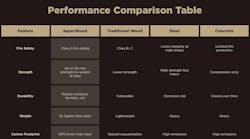Wood, reinvented, has steel in its competitive crosshairs
The word “super,” much like the word “luxury,” has become such a commonly used description that its meaning has lost much of its marketing clout.
“Superwood,” though, might be more than just a branding gimmick. More than a decade in the making, the product, which recently had its commercial launch, claims to be up to 10 times the strength-to-weight of steel, six times lighter than steel, and can achieve a Class A fire rating.
The product has been attracting an unusual amount of press coverage, initially by journals like Scientific American and Nature, and now by mainstream online magazines like Newsweek and Fast Company.
Unlocking wood’s potential
InventWood, the company that produces Superwood from a factory in Frederick, Md., which was funded by a $20 million Department of Energy grant, was cofounded by Liangbing Hu, a Yale professor who began his research in 2013 while working at the University of Maryland’s Center for Materials Innovation. Hu’s ambition has been nothing short of re-engineering wood at a molecular level to unlock its potential as a building product.
His two-step transformation process starts with modifying lignin in the wood, which gives it color and some strength, and selectively removing hemicellulose. Precision densification then collapses the wood’s porous structure and realigns its cellulose fibers to form new bonds. The result is a material that’s 4-20 times stronger and stiffer than natural wood, with 3-10 times greater dent resistance. The altered product, though, doesn’t sacrifice wood’s aesthetic or carbon sequestration properties.
This chemical treatment technology is protected by 144 filed patents, with 41 granted and allowed. According to InventWood’s website, its first products are focusing on exterior applications such as cladding, decking, and dimensional planks, and then could expand into interior products, including furniture, next year. Superwood is currently moving through third-party testing and certification for building code approval for structural applications. Its production capacity for 2025 is fully allocated, and the earliest availability for new orders is expected in 2026.
Could Superwood make construction easier?
Alex Lau, InventWood’s CEO since 2021, suggested to CNN that the commercial application of Superwood could potentially allow for structures to be four times lighter than today, which in turn could make them more earthquake-resistant, and help make construction easier and faster.
Consequently, InventWood is pricing Superwood to be competitive more with other building materials than with wood. “As our production scales up to over 30 million sf annually, we anticipate achieving cost parity with conventional building materials such as steel,” its website states optimistically. InventWood points out, too, that Superwood emits 90% less carbon during manufacturing than steel.
InventWood states that it is actively seeking strategic partnerships across the building materials, design, architecture, distribution, and construction sectors. It also suggested, somewhat coyly, an openness to new venture capital investment.
About the Author

John Caulfield
John Caulfield is Senior Editor with Building Design + Construction Magazine.

